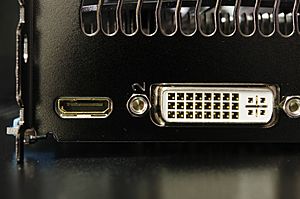Digital Visual Interface facts for kids
The Digital Visual Interface, or DVI, is a special connection for sending video. It helps connect a video source, like a computer, to a screen, like a monitor. DVI usually only sends video. It cannot send sound unless you use a special adapter for HDMI. DVI and HDMI use a similar way to send signals called Transition-minimized differential signaling.
DVI has been very popular in the computer world. Many desktop computers and monitors use it. Most new computers and flat-screen (LCD) monitors have DVI ports. Other devices, like projectors and TVs, can also use DVI, often through HDMI.
Contents
What is DVI?
DVI was created by a group called the Digital Display Working Group (DDWG). Their goal was to replace an older connection type called VGA. DVI was designed to send clear, digital video signals. This means the video data is sent without being compressed.
How DVI Works with Other Connections
DVI works well with both digital and analog signals.
- Digital Mode (DVI-D): This mode sends pure digital video. It works great with HDMI.
- Analog Mode (DVI-A): This mode sends analog video. It can connect to older VGA displays.
Some TVs still have DVI ports, even though HDMI is now more common.
DVI vs. HDMI and VGA
HDMI is a newer type of video connection. Many laptops today have HDMI ports. Fewer laptops have DVI ports. Older laptops often have a VGA connector.
Why DVI Was Important
DVI helped improve how computers connect to screens. It offered a better picture quality than older analog connections like VGA. It was a big step towards clearer digital displays.
Images for kids
See also
 In Spanish: Digital Visual Interface para niños
In Spanish: Digital Visual Interface para niños





